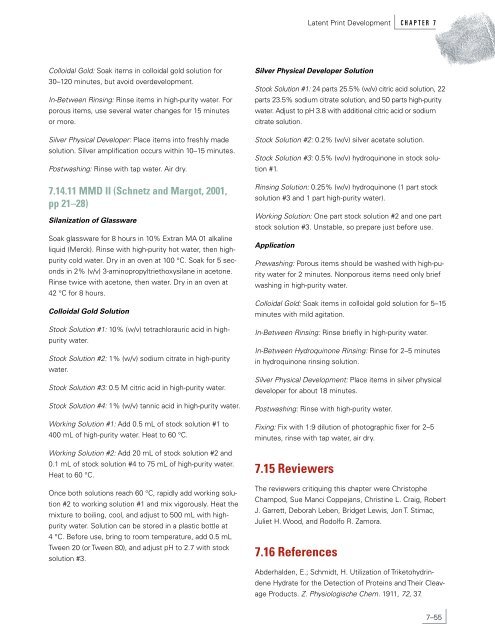Latent Print Development - National Criminal Justice Reference ...
Latent Print Development - National Criminal Justice Reference ...
Latent Print Development - National Criminal Justice Reference ...
You also want an ePaper? Increase the reach of your titles
YUMPU automatically turns print PDFs into web optimized ePapers that Google loves.
Colloidal Gold: Soak items in colloidal gold solution for<br />
30–120 minutes, but avoid overdevelopment.<br />
In-Between Rinsing: Rinse items in high-purity water. For<br />
porous items, use several water changes for 15 minutes<br />
or more.<br />
Silver Physical Developer: Place items into freshly made<br />
solution. Silver amplification occurs within 10–15 minutes.<br />
Postwashing: Rinse with tap water. Air dry.<br />
7.14.11 MMD II (Schnetz and Margot, 2001,<br />
pp 21–28)<br />
Silanization of Glassware<br />
Soak glassware for 8 hours in 10% Extran MA 01 alkaline<br />
liquid (Merck). Rinse with high-purity hot water, then highpurity<br />
cold water. Dry in an oven at 100 °C. Soak for 5 seconds<br />
in 2% (v/v) 3-aminopropyltriethoxysilane in acetone.<br />
Rinse twice with acetone, then water. Dry in an oven at<br />
42 °C for 8 hours.<br />
Colloidal Gold Solution<br />
Stock Solution #1: 10% (w/v) tetrachlorauric acid in highpurity<br />
water.<br />
Stock Solution #2: 1% (w/v) sodium citrate in high-purity<br />
water.<br />
Stock Solution #3: 0.5 M citric acid in high-purity water.<br />
Stock Solution #4: 1% (w/v) tannic acid in high-purity water.<br />
Working Solution #1: Add 0.5 mL of stock solution #1 to<br />
400 mL of high-purity water. Heat to 60 °C.<br />
Working Solution #2: Add 20 mL of stock solution #2 and<br />
0.1 mL of stock solution #4 to 75 mL of high-purity water.<br />
Heat to 60 °C.<br />
Once both solutions reach 60 °C, rapidly add working solution<br />
#2 to working solution #1 and mix vigorously. Heat the<br />
mixture to boiling, cool, and adjust to 500 mL with highpurity<br />
water. Solution can be stored in a plastic bottle at<br />
4 °C. Before use, bring to room temperature, add 0.5 mL<br />
Tween 20 (or Tween 80), and adjust pH to 2.7 with stock<br />
solution #3.<br />
Silver Physical Developer Solution<br />
Stock Solution #1: 24 parts 25.5% (w/v) citric acid solution, 22<br />
parts 23.5% sodium citrate solution, and 50 parts high-purity<br />
water. Adjust to pH 3.8 with additional citric acid or sodium<br />
citrate solution.<br />
Stock Solution #2: 0.2% (w/v) silver acetate solution.<br />
Stock Solution #3: 0.5% (w/v) hydroquinone in stock solution<br />
#1.<br />
Rinsing Solution: 0.25% (w/v) hydroquinone (1 part stock<br />
solution #3 and 1 part high-purity water).<br />
Working Solution: One part stock solution #2 and one part<br />
stock solution #3. Unstable, so prepare just before use.<br />
Application<br />
Prewashing: Porous items should be washed with high-purity<br />
water for 2 minutes. Nonporous items need only brief<br />
washing in high-purity water.<br />
Colloidal Gold: Soak items in colloidal gold solution for 5–15<br />
minutes with mild agitation.<br />
In-Between Rinsing: Rinse briefly in high-purity water.<br />
In-Between Hydroquinone Rinsing: Rinse for 2–5 minutes<br />
in hydroquinone rinsing solution.<br />
Silver Physical <strong>Development</strong>: Place items in silver physical<br />
developer for about 18 minutes.<br />
Postwashing: Rinse with high-purity water.<br />
Fixing: Fix with 1:9 dilution of photographic fixer for 2–5<br />
minutes, rinse with tap water, air dry.<br />
7.15 Reviewers<br />
The reviewers critiquing this chapter were Christophe<br />
Champod, Sue Manci Coppejans, Christine L. Craig, Robert<br />
J. Garrett, Deborah Leben, Bridget Lewis, Jon T. Stimac,<br />
Juliet H. Wood, and Rodolfo R. Zamora.<br />
7.16 <strong>Reference</strong>s<br />
<strong>Latent</strong> <strong>Print</strong> <strong>Development</strong> C H A P T E R 7<br />
Abderhalden, E.; Schmidt, H. Utilization of Triketohydrindene<br />
Hydrate for the Detection of Proteins and Their Cleavage<br />
Products. Z. Physiologische Chem. 1911, 72, 37.<br />
7–55

















